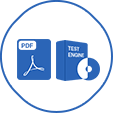Last Update 14 hours ago Total Questions : 98
The Check Point Certified Harmony Endpoint Specialist - R81.20 (CCES) content is now fully updated, with all current exam questions added 14 hours ago. Deciding to include 156-536 practice exam questions in your study plan goes far beyond basic test preparation.
You'll find that our 156-536 exam questions frequently feature detailed scenarios and practical problem-solving exercises that directly mirror industry challenges. Engaging with these 156-536 sample sets allows you to effectively manage your time and pace yourself, giving you the ability to finish any Check Point Certified Harmony Endpoint Specialist - R81.20 (CCES) practice test comfortably within the allotted time.
Which User Roles are on the Endpoint Security Management Server for On-Premises servers?
In the POLICY Tab of the Harmony Endpoint portal for each software capability (Threat Prevention, Data Protection, etc.), rules can be created to protect endpoint machines. Choose the true statement.
Before installing FDE on a client machine, what should administrators make sure of?
What blades have to be enabled on the Management Server for the Endpoint Security Management Server to operate?
The Harmony Endpoint solution includes which three Data Security Software Capability protections?
With which release of Endpoint Client is the Anti-Malware engine based on Sophos instead of Kaspersky?
What connection options does Connection Awareness support?

